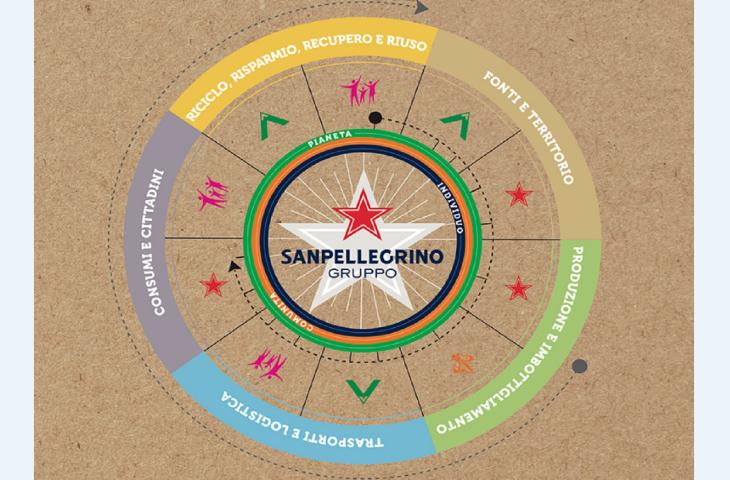MILAN - Taking care of water from the source to the table, reducing the environmental impact, supporting economic and social development and contributing to a future of health and well-being for people. These are the commitments illustrated in the second report on the creation of shared value, from Sanpellegrino, Italy’s leading company in the mineral water and non-alcoholic beverages sector, with around 1,500 employees and products exported to over 150 countries worldwide The Sanpellegrino Group pursues a company policy oriented towards sustainable growth and the creation of shared value. Bottling mineral water is, in fact, a non-relocatable activity that creates value in local communities, with positive repercussions in economic, environmental and social terms.
Bottle-to-bottle and Bio-PET approach
The theme of product end-of-life is increasingly relevant in the approach to the circular economy of Sanpellegrino, one of the first companies to have joined Coripet Coripet – voluntary consortium for the recovery and recycling of PET containers for food liquid – which aims to transform potential waste into a resource in order to put it back into the production cycle.
The report also reflects the commitment of Sanpellegrino, which has been working for years both upstream and downstream of the supply chain to reduce the environmental impact in packaging, reducing the weight of packaging, using recycled material and focusing on raw materials of plant origin. Working on the ‘light weighting’ of packaging, since 2008 to date, the Group has saved 6,000 tons of PET. Sanpellegrino was also the first company in Italy to use recycled PET, progressively increasing its use: in 2017, 3,200 tonnes of recycled PET were used to produce Nestlé Vera bottles which contain over 20%.
The company was also the first to use bottling materials of plant origin, such as BIO-PET produced from sugar cane surpluses, which is capable of offering a 100% recyclable, light, unbreakable, perfectly hygienic and suitable bottle also for carbonated water. In the last year about 700 tons of Bio-PET were used for Levissima, used on 100% of the Litre format and in more than 16% of the carbonated one-and-a-half litre format.
Sustainable logistics
Use of rail transport and load optimisation, production closer to consumers with the multi-sourcing model and collaboration with operators equipped with cutting-edge and low environmental impact means of transport, are the concrete actions developed by Sanpellegrino to promote sustainable logistics. Choices that led to a decrease of 14.8% of the carbon dioxide emitted per litre of water transported between 2012 and 2016.
The Group has consistently favoured the use of rail transport: in 2017, 36% of the mineral water was transported by train and ship, with a shortening of the average routes for entry into operation at full capacity of the Castrocielo plant. Thanks to the adoption of the multi-source model that contributes to enhancing local water resources, bringing the bottling site closer to that of consumption through the distribution of the springs in the national territory, this year again the average distance travelled by Nestlé Vera water in the 2017 was less than 300 km.
The first few months of 2018 saw the completion of the pilot phase of the Green Router project which focused on the Levissima brand with the aim of measuring CO2 emissions from the logistics channel in order to optimise flows and reduce the environmental impact. The systematic use of the railway avoided the emission of 8.268 t of carbon dioxide into the atmosphere which correspond to the average annual emissions of 591 families. Conversely, the use of LNG (Liquefied Natural Gas) powered vehicles has helped to reduce carbon dioxide by 15%, nitrogen oxides by 70% and fine particles released into the atmosphere by 99%. There are 36 LNG vehicles currently used for the transport of Levissima water which will increase to 46 by 2018, corresponding to over a quarter of the entire fleet used by the Group.
Protection of water resources and energy efficiency
Aware of the profound relationship between the protection of the land and the sustainability of its activities, Sanpellegrino is constantly committed to safeguarding water resources, which also includes streamlining its industrial processes. In 2017 the Group saved 115 million litres of water compared to 2016, and further reduced the consumption of water in production processes to 1.76 litres per litre bottled (-2.2% compared to 2014).
The company has also committed to adopting the Alliance for Water Stewardship, i.e. following the AWS standard in Italy, an international benchmark that promotes the sustainable management of the water resource worldwide, to safeguard it and make it available to future generations. The Nestlé Waters Group joined this initiative in 2017, undertaking to certify all its plants by 2025. In Italy, Sanpellegrino, will begin certifying the Nestlé Vera site of Santo Stefano Quisquina (AG), subsequently involving the other 5 plants where its mineral waters are bottled: S.Pellegrino in Sanpellegrino Terme (BG), Levissima in Cepina Valdisotto (SO), Nestlé Vera source in Bosco at San Giorgio in Bosco (PD), Acqua Panna in Scarperia (FI) and Nestlé Vera Naturae in Castrocielo (FR).
The energy performance of the Sanpellegrino Group is also constantly improving. Since 2011, all plants have used 100% of electricity purchased from renewable sources, while CO2 emissions have decreased by 50% over the last 7 years.
Commitment to proper hydration
The report also highlights the Group's commitment to consumer health, by promoting the principles of healthy and proper hydration, especially for children and families, of which the Group’s family-oriented brand, Nestlé Vera is an advocate. In 2017, educational programmes aimed at children and families continued, while the first Italian rulebook for the proper hydration of children, created in 2016, continued to be promoted among paediatricians which has now reached over 28,000 of them.
by Prisca Peroni
10, 15 - 2018











